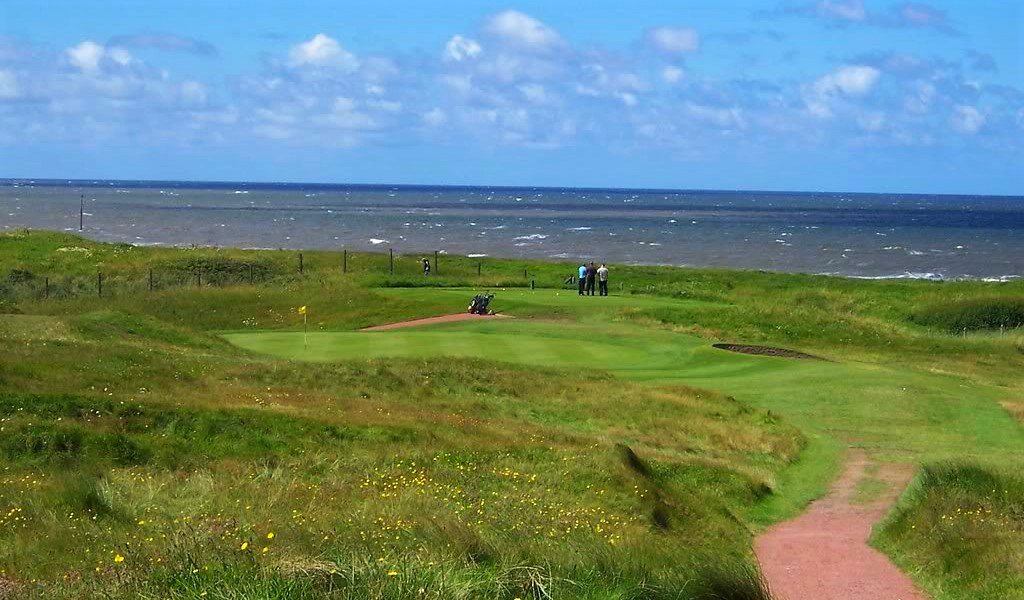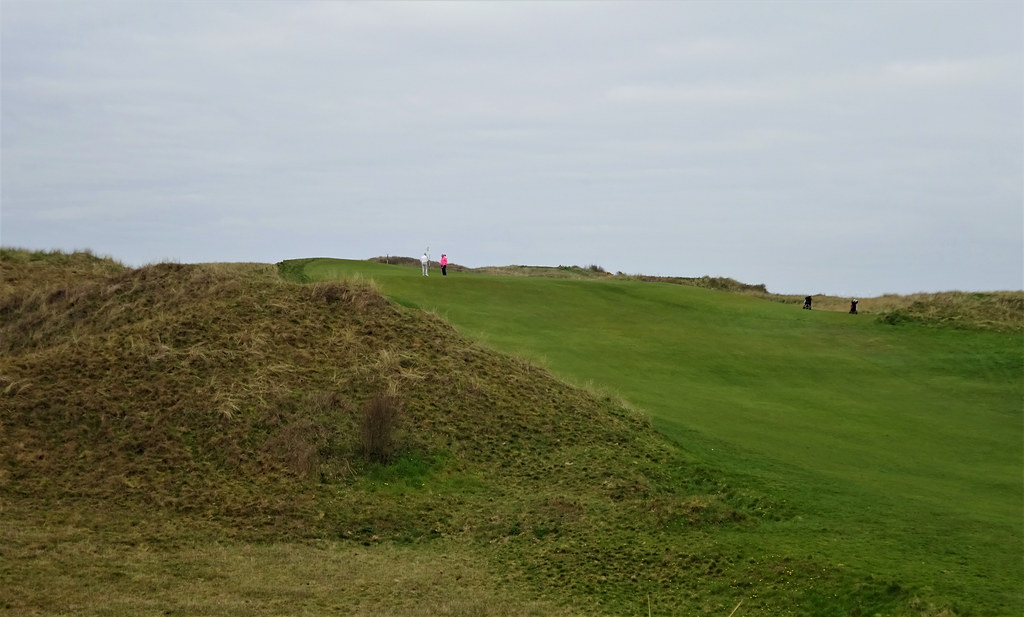
Founded in 1891 by members of nearby Hoylake, Wallasey is very conveniently located for those all visiting Hoylake or the Lancashire links. Old Tom Morris arranged the original layout which has been heavily modified by A Herd, H Hilton, J Braid, Hawtree & Taylor, Donald Steel (2004), M&E and recently the club engaged CDP. Only four OTM greens remain; 2, 7, 8 & 12.
The club has two claims to fame. Wallasey was the site of final qualifying for B Jones' historic 1930 Open victory at Hoylake which eventually led to Impregnable Quadrilateral that same year. Probably the most famous portrait of Jones was commissioned and presented to the club. Jones thought enough of the portrait to sign it and commission a replica for Augusta National.

Second and perhaps more importantly, Wallasey's most famous member, Dr Frank Stableford, devised the very popular Stableford scoring system in 1931 which the club used for the first time in 1932. Dr Stableford served as a civilian doctor in the Boer War and the Somaliland Campaign. Afterward he joined Royal Porthcawl and won the club championship in 1907 off a handicap of +1. Later Dr Stableford would serve as a Major in WWI, being stationed in Malta and Italy where he treated soldiers from the disastrous Gallipoli Campaign. The Frank Stableford Open Amateur Memorial Trophy was first played in 1969 and continues to the present day. None other than Henry Longhurst wrote the following of Dr Stableford, "I doubt whether any single man did more to increase the pleasure of the humble club golfer".

The first is a seemingly straightforward par 4, however, the fairway is interrupted by rough just about where a good drive will finish. The left bunker can be had without too much trouble unless one opts to lay-up in trying to avoid what may be an iffy lie in the rough. This patch of rough breaking up the fairway seems to have some serious drainage issues. The area is much more mucky than usual. Given there is a bank crossing the fairway, I wonder if it wouldn't have been better to build the bunker into it, thus creating a dramatic picture on the first tee. Playing downwind it can be a troublesome to hold the green.
The second is a monster of a hole. The drive plays into the prevailing wind and due to the continuously curving nature of the hole, often times it can be wiser to treat this as a par 5. It is while practicing on the second that F Stableford, after nearly 35 years of tinkering, finally cracked the Stableford scoring.
There is talk of moving the 2nd further right and creating two new holes right of the 2nd. This would open up possibilities to address the flatter par 5 holes (convert to practice ground, 20 holes?) that most seem to think hold back Wallasey from reaching it's potential. Loads of vegetation has been cleared down the right which is welcome regardless of the reason.

After a short climb to the 3rd tee, the player is greeted with a semi-blind tee shot to a narrow saddle fairway. I notice sand has been introduced far up the fairway. There used to be a load of nasty vegetation out there.

Looking back at the tee. I think the front left bunker was removed.

After the clausterphobic 3rd, the world opens on #4. This hole, 5 & 17 were created by Braid in 1938 after issues with the lease of land and the War Office confiscating land beyond the current 5th green and 6th fairway. It wasn't until 1952 that the full 18 hole course was open for play! Despite the huge expanse of fairways, Liverpool Bay will surely weigh heavily on the minds of golfers who prefer a fade. The use of a long berm is also evident between #s 7 & 14.

The 5th is the first of a fine set of short holes. The wind quartering in from the left can create havoc.

One of the few weaknesses of Wallasey is not having a true drivable par 4. The 6th would be a prime candidate for this sort of hole not only because its fairly short anyway, but also because its an opportunity to be bold with a flat section of the property. We are well and truly into flat golf now. The par 5 seventh is reachable in two blows, but one must thread bunkers right and left off the tee and for the approach. These plaques on the tees of holes with original OTM greens are a nice touch.

The 8th makes superb use of OOB by bending right around the practice ground. A pair of bunkers placed exactly where we want to hit a drive requires the golfer to choose between taking sand on for the drive or having to cut across the OOB for a blind second.

Behind the green.

The short ninth takes the golfer surprisingly back to the house, making for a convenient two loops of nine holes. The hole was reworked by Steel in time for the 2004 season. Playing downwind, the golfer has to decide if taking on the bunkers is wise. There is a ridge which creates two distinct green sections. When Bobby Jones qualified for the 1930 Open the 9th played to the current 10 green; a Harold Hilton 1913 addition which was highly regarded.

This is how the hole looked when Bobby Jones played Wallasey in 1930. The current 9th tee to the current 10th green.


The back nine's opening drive has been radically altered by all the trees down the right being removed. The hole turns sharply right then heads uphill to a skyline green. A look at the green from the 11th back tee. The severe uphill approach is from left of the photo where golfers can be seen.

The pick of many as Wallasey's best hole, #11 is a classic down n' up par 4 swinging right to a green resting on a plateau. The driving zone is blind from the tee, but the bunker acts as a target. Below is the approach.

The 12th may be the only hole left as OTM envisioned. Despite playing considerably downhill, with a front to back green and without adverse wind, for some reason, this hole always plays its full yardage. Wide grass walking paths have been introduced in several places.


Probably the best of the three long holes covering the flat. The 13th plays longer still into the prevailing breeze. The hole strikes me as having a less than appealing middle shot to set-up an interesting third. The hole must have been lengthened by about 40 yards when Steel built the new green. While not a hole I particularly like, it does off-set the two downwind par 5s next door.

Another par five, the 14th legs left off fairway bunkers on the left The final four holes take us back to the dunes, but not before we hit one last drive over the flat. A shortish par 4, #15 narrows considerably at the drive zone indicated by the large left bunker. A 200ish yard drive sets up an approach to the the appropriately named Plateau. The harsh 16th finishes the par 3s in style. The bunker is not a bad spot!

#17 plays along the 4th, but in the opposite direction. To earn a view of the green one must hit a good drive into the left rough unless extraordinarily long. Most will face the uphill approach blindly over the corner of the right dune. This isn't one of my favourite holes, but it is awkward and challenging.


Wallasey comes home in grand style. A large dune cuts in from the right necessitating a thoughtful drive. If playing from the back tees, its all out war to hit a long enough drive to reach the green in two even though it will be a blind approach.

An old photo of 18.

The approach after a lonnnggg drive. This is an old photo prior to the clubhouse work which expanded the terrace.

A look at the house from the 9th tee.

There can be little doubt Wallasey is a class course. If one is hard pressed to look for faults, the lack of interesting green surfaces and the flat holes let the course down somewhat. There are unquestionably some very good holes such as 3, 5, 8, 9, 11, 12, 15 and 18. Predictably, these are holes playing through rough and tumble terrain. If one is playing Hoylake, or in North Wales/Lancashire, strong consideration should be given to Wallasey to round out a trip. 2023
Ran's Review.
http://golfclubatlas.com/courses-by-country/england/wallasey000274/Ciao